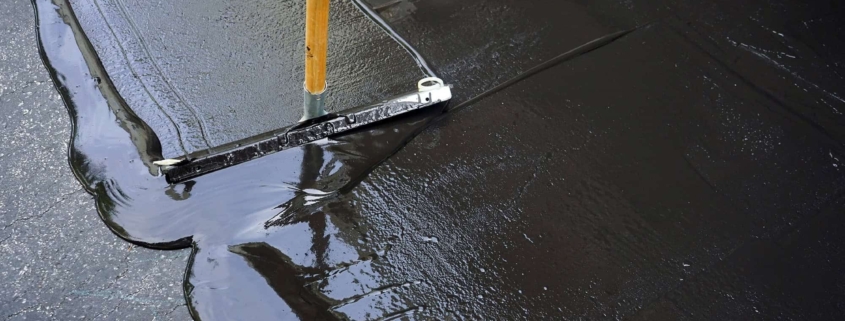Finding the Ideal Temperature for Sealcoating Your Driveway
Here, we’ll be exploring the crucial role of sealcoating and how it acts as the ultimate shield against damage for your asphalt surfaces. But it’s not just about applying a sealcoat; timing and temperature play pivotal roles in the game of pavement protection. Get ready to learn why the optimal temperature range of 50-90 degrees Fahrenheit is the general sealcoating temperature requirement, ensuring longevity and beauty for your driveway. Let’s steer through the optimal conditions for sealcoating that secure both durability and curb appeal.
Why Weather Plays a Pivotal Role in Sealcoating Your Driveway
Most homeowners recognize that temperature affects the sealcoating process, but weather conditions extend far beyond the simple thermometer reading. No element operates in isolation, and when sealcoating your driveway, understanding the comprehensive impact of weather—be it sunny or cloudy, dry or wet—can be the difference between a successful application and a flawed one.
The Impact of Sunshine and Cloud Cover
While temperature dictates the optimal conditions for sealcoating, the presence of direct sunshine can accelerate the curing process. Conversely, a cloudy sky might prolong the drying time, necessitating a longer period before the driveway is ready for use again. This does not necessarily spell problems, but it does require additional planning to ensure the sealcoat sets properly.
Humidity and Sealcoating: A Delicate Balance
Humidity is another critical factor that influences sealcoating success. High humidity levels can slow down the evaporation of the water in the sealcoating mix, leading to longer drying times. In extreme cases, it can even prevent proper curing, resulting in a tacky finish that can attract dirt and fail to provide the protection your driveway needs.
Sudden Temperature Shifts: The Silent Enemy of Sealcoating
Sudden swings in temperature can wreak havoc on freshly applied sealcoat. If the mercury dips too low soon after application, it can halt the curing process in its tracks. Rising temperatures can pose a similar issue, causing the sealcoat to become too fluid and, as a result, less effective.
- Early morning or late evening hours may be ideal for application to avoid the intense midday heat or cool overnight temperatures.
- Monitoring the weather forecast for consistent conditions can help in planning the perfect day for sealcoating.
- It’s essential to avoid days when a sudden rain is expected, as water can dilute the sealcoat and prevent it from adhering properly.
Seasonal Considerations for Sealcoating
Understanding the seasonal dynamics is crucial for a successful driveway sealcoating. The key is to harness the right weather conditions to ensure the sealant adheres properly and provides your driveway with optimal protection.
Best Seasons for Sealcoating Services
The moderate temperatures and predictable weather patterns of late spring to early fall make these seasons most favorable for sealcoating. Ideally, you should aim for a temperature range between 50 and 90 degrees Fahrenheit. During this period, the warmth aids in proper sealant curing and daylight offers ample time for application and drying.
Planning Around Unpredictable Weather Patterns
Unfortunately, seasons can surprise us with erratic weather changes. Here are some tips to prepare for these uncertainties:
- Check the forecast: Always keep an eye on the seasonal forecast before scheduling your sealcoating. A stretch of dry weather is your best bet.
- Flexibility: Be prepared to adjust your plans according to the latest weather updates. A little flexibility can go a long way in avoiding a sealcoating disaster.
- Professional Insight: Sealcoating companies are well-versed in tackling the whims of nature. If in doubt, consult a professional for the best course of action.
Sealcoating your driveway is an investment in preserving its integrity and appearance. Selecting the right season for this task will ensure that your driveway is protected for years to come. Keep these considerations in mind when planning your next sealcoating project.
Curing Time and Considerations for Optimal Driveway Sealcoating Temperature
When it comes to sealcoating your driveway, understanding the curing process and the role of temperature for sealcoating your driveway is crucial for achieving long-lasting results. The curing time is the period needed for the sealcoating to fully harden and offer maximum protection. This process can be significantly influenced by the temperature at the time of application and throughout the curing period.
Optimal Conditions for Sealcoating Cure
The ideal temperature for sealcoating your driveway is generally between 50°F and 85°F (10°C to 30°C). When temperatures fall within this bracket, the sealcoat can dry and cure properly, ensuring a smooth and durable finish. Conversely, temperatures outside of this range can lead to issues that may affect the longevity and effectiveness of the sealcoat.
Too Hot or Too Cold: Temperature Extremes and Their Impact
Sealcoating in temperatures that are too low can severely hinder the curing process. If the temperature drops below 50°F (10°C), the sealcoat may not dry properly, leading to a tacky surface that can be tracked by vehicles and even pedestrians. Additionally, the sealcoat will be less resistant to wear and weather conditions, shortening its service life.
Conversely, applying a sealcoat when the temperature is too high can also be problematic. Temperatures above 85°F (30°C) may cause the sealant to cure too quickly, leading to an uneven finish that’s prone to cracks and other defects. Furthermore, a sealcoat that dries too fast may not adhere well to the asphalt, reducing its protective qualities.
Guidelines for Ensuring Proper Sealcoating Cure
Check the weather forecast before starting the sealcoating project to ensure the temperature for sealcoating a driveway will be within the recommended range and remain stable for at least 24 to 48 hours.
Avoid sealcoating if there is a risk of temperatures dropping below 50°F (10°C) or rising above 85°F (30°C) during the curing period.
Apply sealcoating during periods of low humidity when possible, as high humidity can extend drying times.
Monitor the surface regularly and protect it from traffic and debris until the sealcoat has completely cured.
By paying close attention to temperature and weather conditions during the curing process, you can ensure that your sealcoating effort results in a robust and resilient driveway surface. This is a crucial step that should not be overlooked in the sealcoating process.
For expert guidance on all your asphalt paving needs, visit our asphalt services page to discover how Phillips can transform your surfaces with quality and precision.
Protect Your Driveway With Phillips
Ready to safeguard your driveway with professional sealcoating services? Contact Phillips Paving today to schedule your consultation and experience the difference our expertise can make.




